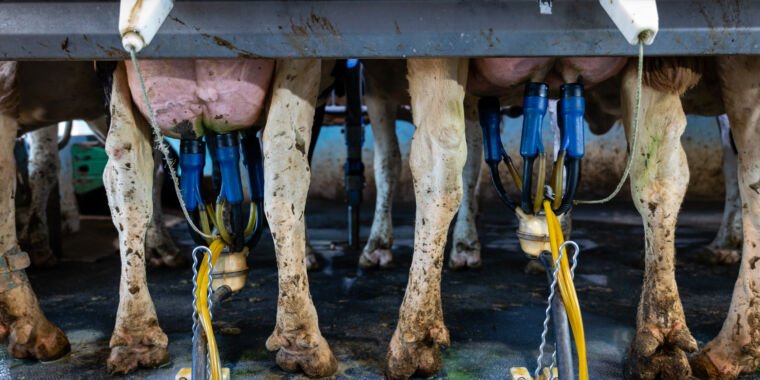Bird flu is spreading rapidly in California; infected herds double over weekend

The H5N1 bird flu appears to be stampeding through dairy farms in California, the country’s largest milk producer. Over the weekend, the total number of confirmed infected cow herds stunningly doubled, going from 17 last Thursday to 34 Monday morning, according to state and federal officials.
With the new tally, California now ranks second among all affected states for having the most herds with avian influenza. Only Colorado, which has adopted bulk milk-tank surveillance, has more, with 64 herds confirmed. California’s high ranking is despite the fact that it only reported its first three infected herds on August 30, while the dairy outbreak was first confirmed on March 25 and thought to have begun late last year.
To date, 232 herds in 14 states have been infected with the bird flu.
In an announcement last week, California officials said the batch of herds that tested positive were “targeted for testing due to elevated risks from their recent connections with the initial affected premises.” They called the positive results “not unexpected” and reported that they fit with the state’s plans of finding infections as early as possible. “Early detection provides the opportunity to work with farms to quickly implement enhanced biosecurity, cow care, and employee protection.”
When the state’s first infected herds were announced, California Department of Food and Agriculture Secretary Karen Ross touted the state’s preparations and readiness. “Our extensive experience with [highly pathogenic avian influenza] in poultry has given us ample preparation and expertise to address this incident,” Ross said. She further assured dairy farmers that they are approaching the outbreak with the “utmost urgency.”
Troubling transmission
The news comes as public health experts are concerned about a puzzling case of H5 bird flu in a person in Missouri, who had underlying medical conditions but no known exposure to animals. The case is the 14th human infection amid the dairy cow outbreak this year. All of the 13 prior infections were in farmworkers known to be exposed to infected animals: nine in poultry workers and four in dairy workers. But Missouri has not reported H5N1 in dairy herds and hasn’t had recent outbreaks in poultry facilities, either.
While the Missouri case has recovered, health officials are stumped about how that person became infected. In a press briefing earlier this month, an official with the Centers for Disease Control and Prevention suggested the case could be a “one-off.” But, the CDC has reported that another person in the household with the Missouri case fell ill at the same time, suggesting a possible common exposure to the virus. That household contact was not tested for flu and has also since recovered. The CDC is now conducting serological testing to see if the household member has developed antibodies against the bird flu, indicating a previous infection.
The CDC has also reported that a health care worker who interacted with the patient fell ill, but tested negative for flu. On Friday, the CDC reported that a second health care worker became ill with a mild respiratory illness after interacting with the Missouri case but was not tested for flu and recovered before the investigation began. The CDC will offer serological testing for that health care worker, too.
While there’s no evidence of human-to-human transmission yet, health experts fear that there is not enough testing—of case contacts, animals, or farmworkers—and transmission is going unseen. As the wily influenza virus spreads across the country to new mammalian species, it gains new opportunities to adapt to humans and cause more severe disease. Influenza experts have long feared that the virus has pandemic potential.
Source link




